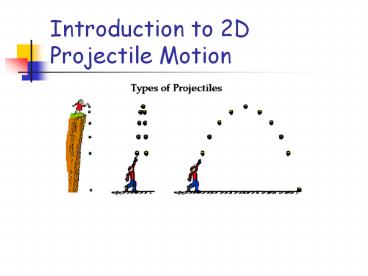Introduction to 2D Projectile Motion - PowerPoint PPT Presentation
Title:
Introduction to 2D Projectile Motion
Description:
Introduction to 2D Projectile Motion Projectile Motion An example of 2-dimensional motion. Something is fired, thrown, shot, or hurled near the earth s surface. – PowerPoint PPT presentation
Number of Views:418
Avg rating:3.0/5.0
Title: Introduction to 2D Projectile Motion
1
Introduction to 2D Projectile Motion
2
Projectile Motion
- An example of 2-dimensional motion.
- Something is fired, thrown, shot, or hurled near
the earths surface. - Horizontal velocity is constant.
- Vertical velocity is accelerated.
- Air resistance is ignored.
3
Trajectory of Projectile
- This projectile is launched an an angle and rises
to a peak before falling back down.
4
Trajectory of Projectile
- The trajectory of such a projectile is defined by
a parabola.
5
Trajectory of Projectile
Range
- The RANGE of the projectile is how far it travels
horizontally.
6
Trajectory of Projectile
Maximum Height
Range
- The MAXIMUM HEIGHT of the projectile occurs
halfway through its range.
7
Trajectory of Projectile
- Acceleration points down at 9.8 m/s2 for the
entire trajectory.
8
Position graphs for 2-D projectiles
9
To work projectile problems
- you must first resolve the initial velocity into
components.
Vo
?
10
Trajectory of Projectile
v
v
v
vo
vf
- Velocity is tangent to the path for the entire
trajectory.
11
Trajectory of Projectile
vx
vx
vy
vy
vx
vy
vx
vy
vx
- The velocity can be resolved into components all
along its path.
12
Trajectory of Projectile
vx
vx
vy
vy
vx
vy
vx
vy
vx
- Notice how the vertical velocity changes while
the horizontal velocity remains constant.
13
Trajectory of Projectile
vx
vx
vy
vy
vx
vy
vx
vx
vy
- Where is there no vertical velocity?
14
Trajectory of Projectile
vx
vx
vy
vy
vx
vy
vx
vx
vy
- Where is the total velocity maximum?
15
2D Motion
- Resolve vector into components.
- Position, velocity or acceleration
- Work as two one-dimensional problems.
- Each dimension can obey different equations of
motion.
16
Horizontal Component of Velocity
Newton's 1st Law
- Is constant
- Not accelerated
- Not influence by gravity
- Follows equation
- x Vo,xt
17
Horizontal Component of Velocity
18
Vertical Component of Velocity
Newton's 2nd Law
- Undergoes accelerated motion
- Accelerated by gravity (9.8 m/s2 down)
- Vy Vo,y - gt
- y yo Vo,yt - 1/2gt2
- Vy2 Vo,y2 - 2g(y yo)
19
Horizontal and Vertical
20
Horizontal and Vertical
21
Launch angle
Zero launch angle
22
Launch angle
Positive launch angle
23
Symmetry in Projectile Motion
Launch and Landing Velocity
Negligible air resistance
Projectile fired over level ground
24
Symmetry in Projectile Motion
Time of flight
25
Symmetry in Projectile Motion
Time of flight
Projectile fired over level ground
Negligible air resistance

